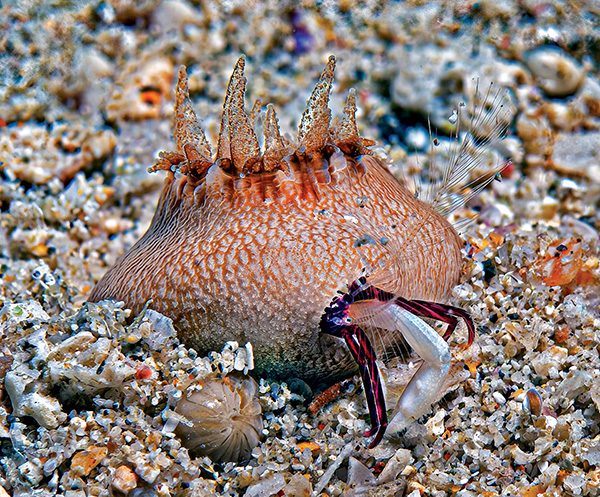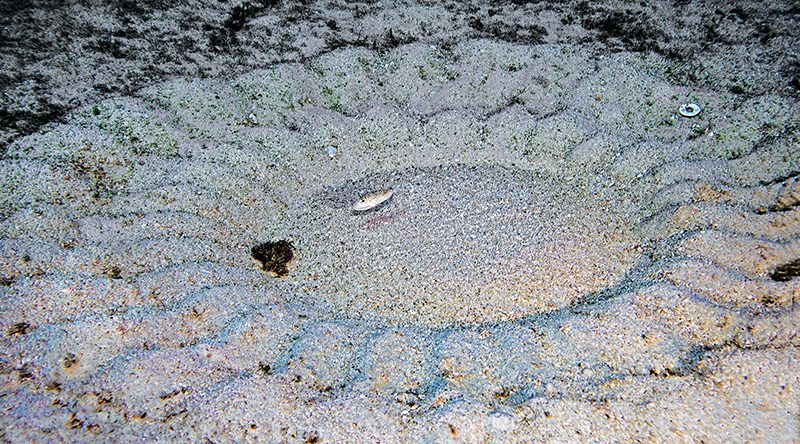MUCHOS BUZOS JAPONESES ADORAN A LAS CRIATURAS SUBMARINAS particularly the home-grown varieties living in abundance along the country’s craggy volcanic coastlines and offshore islands. They also have an infatuation for the eccentric — the stranger the better.
News spread quickly across the country following the 1995 discovery of mysterious 6-foot, crop-circle-like sand structures adorning the inshore seabed off Amami Ōshima, one of Japan’s southernmost islands.
El creador de los desconcertantes círculos no fue identificado hasta 2011, cuando un curioso fotógrafo submarino descubrió a la mente maestra detrás de las fascinantes hazañas. El heroico excavador de la tarea titánica era un pez globo de 10 cm (4 pulgadas) desconocido y sin nombre, que era completamente adorable y sus masivas esculturas geométricas eran realmente impresionantes.
Researchers investigated the motive behind the puffers’ extravagant efforts and found that the labyrinthine sandcastles — sculpted by tens of thousands of lineal trenches plowed by tiny thrashing fins — serve as enchanting love nests to beguile mates.
It wasn’t just local interest that was piqued by the delightful findings. In the summer of 2017, an episode of Big Pacific (El gran Pacífico) en PBS presentó a los telespectadores las intrigantes proezas del pez globo, Torquigener albomaculosus. Anna and I were instantly drawn into the captivating four-minute segment depicting one of the seas’ most sophisticated examples of sexual selection — an exceptional behavior where the females have the upper hand in selecting mates.

A single species of hermit crab, Diogenes heteropsammicola, has adapted to live symbiotically with solitary polyps of walking coral inhabiting Amami’s sandy underwater terrain. The hermit crabs use their long pair of antennae to filter organic food particles from the water.
For the longest time it didn’t occur to us that we could and should visit these puffers. Our mindset changed when we received word that we had a connection in Amami: Ume, our capable divemaster from a previous trip to Japan, now owns and operates a small dive center on the island.
We flew with two friends from Tokyo to Amami. Two hours later the wheels touched down on a forested green mountainscape rising from the bluest of seas. Long celebrated for its unique biodiversity, this isolated island — the seventh-largest in Japan — was added to UNESCO’s World Heritage List in 2021.
El siempre sonriente Ume y dos camionetas nos recibieron —y también a nuestro terrorífico montón de equipaje— en el aeropuerto. Nos llevaron rápidamente para disfrutar de una excursión de 80 minutos por acantilados cubiertos de verde a través de 13 túneles de montaña y en torno a una vasta laguna bordeada por manglares y repleta de kayakistas. Llegamos al extremo opuesto de la isla, donde los misteriosos círculos fueron descubiertos, e hicimos el primero de los dos buceos con peces globo a la mañana siguiente.
From a shallow mooring we set off behind Ume, who led us over a ridge and down a deep sand slope stretching as far as we could see. This empty world of endless sand and few predators seemed a practical location to build a nest for tasty, fat-filled eggs. But the solitude suggested another matter: How will the males attract mates to the middle of nowhere? An acceptable enticement would have to be faultless in every detail with whatever premium that would tickle a female’s fancy.

Un pez globo macho muy ocupado termina la primera etapa de construcción de un intrincado nido de huevos de 1,8 metros (6 pies) para impresionar a las hembras.
Con el tiempo los peces globo resolvieron el asunto de una excelente manera, y crearon un castillo de arena circular diseñado con precisión y adornado con baratijas marinas. Los investigadores registraron abundantes desoves en su primera temporada de monitoreo de los círculos. Hembras un poco más grandes visitan los proyectos de edificación durante la construcción, lo que hace que los laboriosos machos se esfuercen aún más.
The seven- to nine-day project ends when the first gravid female enters the central circle. Positioned side-by-side, the pair releases gametes into an irresistible bed of the finest sand funneled by structurally precise hydrodynamic channeling of currents and the male’s relentless churning. After mating with multiple partners for several days, the father-to-be stands guard until his offspring hatch six days later.
Nuestra visita a principios de mayo coincidió con la finalización de la primera etapa de construcción con todos los círculos, picos y surcos radiales terminados. Durante la semana entrante el pez globo macho perfeccionó las partes toscas hasta alcanzar la excelencia y le agregó detalles con trozos de corales y conchas. Pero había mucho más para ver en Amami.
On the way back to the boat, I spy Anna waving me over to yet another extraordinary natural history narrative. The seemingly vacant seabed is home to two species of walking corals that settle from the pelagic onto small gastropod shells already colonized by tiny, symbiotic peanut worms. As each solitary polyp spreads a protective calcium covering over its vulnerable body, it leaves a tiny opening. The hole allows the detritus-picking worm to feed and pull the thimble-sized corallite about, inchworm style, while keeping the host’s delicate tentacles upright and unburied.
We studied the strange symbiotic relationship years ago in Bali. But we’re in Amami, so there has to be a twist. Sure enough, an endemic filter-feeding hermit crab has evolved — slender body and all — to usurp the worms’ coral-toting duties. AD
© Alert Diver - Q4 2023